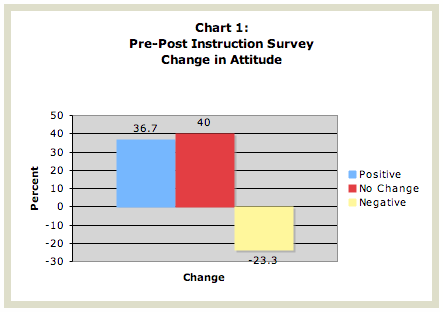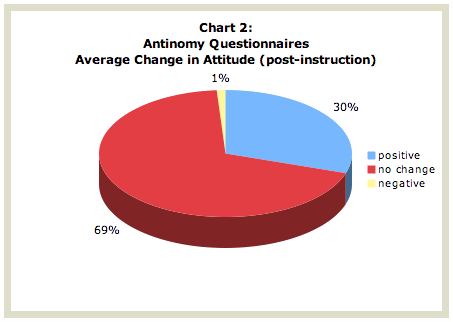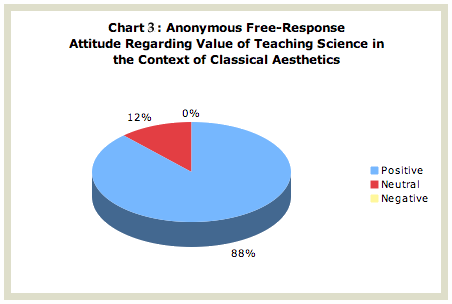This action research project set out to answer three questions: (1) Will students recognize the legitimate value of learning science in the context of Classical Aesthetics? (2) Will students demonstrate a growth in aesthetical and philosophical knowledge particularly as it pertains to nature and the nature of science? (3) Will students begin to incorporate the language of Classical Aesthetics in their understanding and descriptions of nature and the nature of science? The research project employed an Initial/Final (also referred to as the Pre-Post Instructional) Survey, a series of Antinomy Questionnaires, and an Anonymous Free-Response Survey to provide triangulated results on each of the above questions. A complete analysis of these results can be found in the Appendixes. Summary results of these research tools are used in the discussion that follows.
Question 1: Will students recognize the legitimate value of learning science in the context of Classical Aesthetics?
To answer this question the surveys and questionnaires attempted to measure the change in student’s “attitude” regarding the value of incorporating aesthetics and philosophy into science instruction. The results are summarized below.

The data indicates that there was an approximate 37percent increase in the number of students who believed that aesthetical and philosophical instruction in science was of value. Along with this there was a 23 percent decline in the number of students who thought that this was either irrelevant or a bad idea to include aesthetics & philosophy in science instruction. 40 percent of the participants did not demonstrate a change their attitude. See Chart 1.

Participants in the study received instruction on five ontological antinomies. Prior to instruction they completed a questionnaire; then after several days of instruction they retook the questionnaire. Their responses were compared noting the change in attitude that may or may not have occurred regarding the value and relevance of this particular antinomy to their understanding of science. On average, 30 percent of the students found the discussion of ontological antinomies valuable and relevant while 69 percent did not register any change in attitude towards the information presented to them. Only one student stated that they thought that the information was of no value and irrelevant to his/her understanding of science. See Chart 2.

At the end of the project the participants were asked to respond to the following question: "Was this [learning science in the context of classical aesthetics] a valuable experience? Why?" They were asked to keep their responses anonymous although several did include their names. A remarkable 88 percent said that it was a valuable experience while 12 percent did not register a change in attitude regarding its value. Although none of the students expressed a negative attitude regarding the experience, one of the participants expressed uncertainty. She based this on the fact that although she thought it was “somewhat” beneficial to learn about other philosophies and beliefs this was negated by the fact that she had not changed her opinion on any of the matters discussed. See Chart 3.
Table 3: Sample Student Reponses
Attitude Regarding the Value of Teaching of Science in the Context of Classical Aesthetics
Pre-Post Instruction Survey
|
• "I think students would have greater appreciation for science if they understood the beauty of it. Then, I think that would make them more motivated to learn science and do well in the class."
• "I think science would be more interesting if we saw it through the context of the True, the Good, and the Beautiful."
• "Beauty is an important part of science; some organisms that are beautiful should not be messed with, example of the oyster." [Oyster reference related to researchers who discovered the oldest living thing but had destroyed it in the process of discovering it.]
• "Beauty might not be what people think of first when it comes to science, but I think it has a fairly important significance. I mean, if you think something is beautiful and are at awe by it, wouldn't you want to learn more about it?"
• "It is important to see the big picture of science and the simplicity of scientific findings/implications and how they fit in. The beauty is that it all works and that we're here to study it."
• [Should beauty be included in science instruction?] "It should because it helps us appreciate and therefore understand our world around us." |
Antinomy Questionnaires |
• "I feel that it is amazing how an artist can take tiny dots and lay them together to make something great. [referring to a painting by Seurat]. It is the same concept as the orchestra. If the dots are not organized, the many turning into one is not goint to work to the fullest extent. I had never realized that pictures and everything in the world are made up of tiny things, or "ones" whether they be pixels or atoms, etc."
• "While the idea of a supreme being is sometimes hard to accept...I think the "proof" is in the beauty, [and] complexity of nature." |
Anonymous Free-Response |
• "This was extremely valuable for may reasons. It opened up science in a new way for me to incorporate philosophy and freedom of thought into the scientific field which I had previously considered really strict."
• "I see everything differently now. I also use this stuff in other classes to help explain unclear things."
• "It has allowed me to view science in a different context."
• "I learned alot and took my mind to places I didn't even knew exist."
• "It taught me to look at the paradoxes, which I probably would not have thought about before, and thought about the necessity of an equilibrium between the two. Our world consists of paradoxes that coexist to make our world possible."
• "By giving Beauty a chance, I hope to be more open-minded."
• "You get to appreciate the beauty within science and science is not all about trying to find an answer."
• "I think that they should teach this because it helps students understand the true meaning of beauty in science."
• "I would like to continue to learn this subject. it was very interesting and enlightening."
• "It helped me on the '07 SAT prompt."
• "At first I wasn't paying attention but...I actually bgan to appreciate the beauty within philosophy. I didn't even know some of the ideas we learned even existed."
• "It is very relevant to my life and crucial for my understanding and appreciation of nature."
• "Yes. It was because it gave me a chance to think about things I've never really thought about. It has opened my mind to new ideas and even changed my point of view about certain things."
• "Was this a valuable experience?—somewhat. Why?—It is nice to know about all the philosophy, and philosophers, and beliefs. Why not?—My opinions did not change." |
Question 2: Will students demonstrate a growth in aesthetical and philosophical knowledge particularly as it pertains to nature and the nature of science?
The three tools that were used to answer this question were the Initial/Final Survey, the Antinomy Questionnaires, and the Anonymous Free-Response Survey. The complete analysis of these tools are provided in Appedixes … , respectively. The results that follow summarize these findings.

The data indicates that there was an approximate 35 percent increase in the knowledge gained by students as a result of instruction. 65 percent of the students did not demonstrate an increase in this knowledge domain as evinced by the survey. See Chart 4

Participants in the study received instruction on five ontological antinomies. Prior to instruction they completed a questionnaire; then after several days of instruction they retook the questionnaire. Their responses were compared noting the increase in knowledge that may or may not have occurred with respect to this particular antinomy relative to their understanding of science. On average, 49 percent of the students demonstrated an acquisition of knowledge while 51percent did not demonstrate a measurable increase in knowledge. See Chart 5.

At the end of the project the participants were asked to respond to the following question: "Was this [learning science in the context of classical aesthetics] a valuable experience? Why?" They were asked to keep their responses anonymous although several did include their names. 88 percent claimed that they had learned something from the experience. Only twelve percent of the respondents made no indication that they had learned something from the experience. No one expressed a negative view regarding the instruction or that it had hindered his or her learning of science. See Chart 6.
Table 4: Sample Student Reponses
Demonstration of Growth in Knowledge in Aesthetics and Philosophy
Pre-Post Instruction Survey |
• "Science and intuition reveal different truths to humanity, and together, they form a holistic understanding."
• "I learned a lot of things that might affect y decisions in the future. Before I would think that if someone sees beauty in what I think is ugly, I would assume that he is weird and out of this world, But now I consider the fact that the beauty of the object is no perceptible to me, but to that person."
• "Science and other things can combine to enhance our complete understanding of the world."
• "Science shouldn't take advantage of non-human organisms for the benefit of science."
• "...bioethics and holding science to a standard of morality is important for animals, nature, and the environment."
• "Beauty exists independent of the subject[s] mind." |
Antinomy Questionnaires |
• "The symphony was another perfect example of One/Many. Each instrument has its own sound and each player has heir own style, but together, they formed beautiful music. They all play seperate and different notes, but somehow come together to create a lovely melody. Each instrument is an individual but together creates an orchestra."
• " You take chaos (the unknown) and solve it and write laws to turn it into order."
• "Science is ordered because it is beautiful, therefore there is simplicity and symmetry."
• "Everyone is in perfect unison [Viennese Waltz] which would be enough to drive me crazy. As cool as it is to look at...I would fall asleep actually experiencing it. There needs to be a balance between the two extremes of order and chaos."
• "This idea—or a generation of people who seem to believe the world revolves around themselves [the I as transcendent]—is disturbing. By focusing on the immanent they miss the radiance of the transcendent. The idea that there is something greater than themselves out there!"
• "Mystery is beauty waiting to be unraveled. The secretive component to mystery is what influences us to gain to knowledge to that truth within mystery."
• "Mystery is what keeps men honest. Mystery is a safeguard, the watcher of power, it is knowledge's balance." [In response to, "If knowledge is power, what is Mystery?] |
Anonymous Free-Response Survey |
• "I see everything differently now. I also use this stuff in other classes to help explain unclear things."
• "It has allowed me to view science in a different context."
• "I learned a lot and took my mind to places I didn't even knew exist."
• "It taught me to look at the paradoxes, which I probably would not have thought about before, and thought about the necessity of an equilibrium between the two. Our world consists of paradoxes that coexist to make our world possible."
• "By giving Beauty a chance, I hope to be more open-minded."
• "You get to appreciate the beauty within science and science is not all about trying to find an answer."
• "It helped me on the '07 SAT prompt."
• "At first I wasn't paying attention but...I actually began to appreciate the beauty within philosophy. I didn't even know some of the ideas we learned even existed."
• "It is very relevant to my life and crucial for my understanding and appreciation of nature."
• "Yes. It was because it gave me a chance to think about things I've never really thought about. It has opened my mind to new ideas and even changed my point of view about certain things." |
Question 3: Will students begin to incorporate the language of Classical Aesthetics in their understanding and descriptions of nature and the nature of science?
The three tools that were used to answer this question were the Initial/Final Survey, the Antinomy Questionnaires, and the Anonymous Free-Response Survey. The complete analysis of these tools are provided in Appedixes … , respectively. The results that follow summarize these findings.

The data indicates that there was an approximate 47 percent increase in the employment of domain specific vocabulary gained by students as a result of instruction. 53 percent of the students did not demonstrate an increased use of aesthetical/philosophical language in their survey question responses. See Chart 7.

Participants in the study received instruction on five ontological antinomies. Prior to instruction they completed a questionnaire; then after several days of instruction they retook the questionnaire. Their responses were compared noting the increase in aesthetical/philosophical language that they employed while responding to the antinomy questionnaire. On average, 35 percent of the students demonstrated a use of domain specific language while 65 percent did not demonstrate the use of aesthetical/ philosophical vocabulary. See Chart 8.

At the end of the project the participants were asked to respond to the following question: "Was this [learning science in the context of classical aesthetics] a valuable experience? Why?" They were asked to keep their responses anonymous although several did include their names. 25 percent of the students responded by employing terminology that was domain specific to aesthetics and philosophy or at least using terminology that they were unlikely to have used in this context prior to instruction. 75 percent of the students did not use domain specific language in their response to this question. See Chart 9.
Table 5: Sample Student Responses
Demonstration of the use of the Language Aesthetics and Philosophy
Pre-Post Instructional Survey |
• "It is important to see the big picture of science and the simplicity of scientific findings/implications and they fit in. The beauty is that it all works and that we're here to study it all. Also, bioethics and holding science to a standard of morality is important for animals, nature, and the environment."
• "This actually helped me in my other classes. I talked about noesis in English when we read a story about an out-of-body experience."
• "Beauty might not be what people think of first when it comes to science, but I think it has a fairly important significance. I mean, if you think something is beautiful and are in awe by it, wouldn't you want to learn more about it?"
• "Science and intuition reveal different truths to humanity, and together, they form a holistic understanding."
• "Before I would think that if someone sees beauty in what I think is ugly, I would assume that he is weird and out of this world. But now I consider the fact that the beauty of the object is not perceptible to me, but to that person." |
Antinomy Questionnaires |
• "I feel that it is amazing how an artist can take tiny dots and lay them together to make something great. [referring to a painting by Seurat]. It is the same concept as the orchestra. If the dots are not organized, the many turning into one is not going to work to the fullest extent. I had never realized that pictures and everything in the world are made up of tiny things, or "ones" whether they be pixels or atoms, etc."
• "Science is ordered because it is beautiful, therefore there is simplicity and symmetry."
• "You take nothing (chaos) (mediums, canvas, clay, graphite) and turn it into something beautiful (order)."
• "I have experienced the transcendent in a piece of music, and when I was listening to it, it seems like the whole worlds stops to listen to this song. The music was beautiful. The harmony of the instruments, the symmetry of the beats and the radiance of the lyrics made it beautiful. It made me feel alive and it moved me. For some it was just an ordinary song."
• "Mystery is beauty waiting to be unraveled. The secretive component to mystery is what influences us to gain to knowledge to that truth within mystery."
• "Mystery is what keeps men honest. Mystery is a safeguard, the watcher of power, it is knowledge's balance."
Response to Red Violin video clip:
"Jackson [actor who played the violin appraiser] accepted the violin in all its mystery, but the scientist did not accept it. He wanted to become more knowledgeable of it."
• "Jackson accepts the violin for what it is and he doesn't know what to do with it. The scientist is only in it for the knowledge and he wants to break it apart to find its secrets.... They make a choice between a perfect violin or the destruction of it to find out how it works." |
Anonymous Free-Response |
• "It taught me to look at the paradoxes, which I probably would not have thought about before, and thought about the necessity of an equilibrium between the two. Our world consists of paradoxes that coexist to make our world possible."
• "You get to appreciate the beauty within science and science is not all about trying to find an answer." |
|

